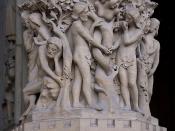American Romanticism
Biblical Similarities in Hawthorne's "Rappaccini's Daughter"
In Nathanial Hawthorne's "Rappaccini's Daughter," many biblical parallels can be found. This short story duplicates the first three chapters of Genesis in the Bible. The similarities range from the characters, to the setting, and even to the deadly plant in the story. The account of Adam and Eve in Genesis chapters 1-3 is extremely similar to the situation of Giovanni and Beatrice in "Rappaccini's Daughter".
In both "Rappaccini's Daughter" and the Genesis chapters in the Bible, lush, beautiful gardens are the setting. Both gardens are exotic and pretty, but the Garden of Eden is bright and tropical, whereas Dr. Rappaccini's garden is dark and mysterious. Both gardens are home to a type of "forbidden" plant, but the Garden of Eden was created by God, whereas the garden in the story is created by a man with a god complex, Dr.
Rappaccini.
The forbidden plant in Genesis is a gorgeous fruit tree. The tree in the Garden of Eden is called the Tree of Knowledge and was extremely tempting to Adam and Eve. However, the tree was deemed prohibited by God. The plant in Rappaccini's garden is a large flowering bush. The flowers on this bush are unlike any others and are extremely exquisite. The two plants share the trait of "forbidden," but in different ways. The fruit on the tree in Genesis was forbidden because God said so. The plant in Rappaccini's garden was forbidden because it was poisonous. The only person immune to the poison of this plant was Beatrice, then soon Giovanni.
In Hawthorne's story, a parallel between Giovanni and Adam is established. Both are young men, and each were tempted by a beautiful young woman. Giovanni in Hawthorne's story was...

![[Piazza di San Giovanni in Laterano, Rome, Italy] (LOC)](https://s.writework.com/uploads/8/89974/piazza-di-san-giovanni-laterano-rome-italy-loc-thumb.jpg)
